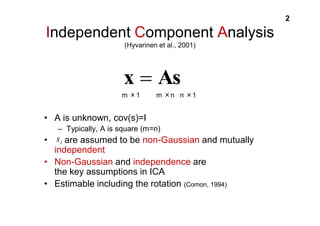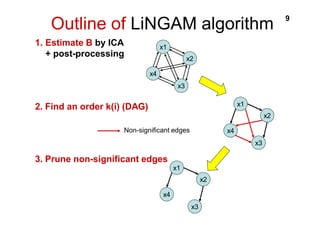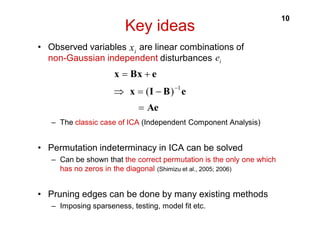Discovery of Linear Acyclic Models Using Independent Component Analysis
- 1. Created by S.S. in Jan 2008 Discovery of Linear Acyclic Models Using Independent Component Analysis Shohei Shimizu, Patrik Hoyer, Aapo Hyvarinen and Antti Kerminen LiNGAM homepage: http://www.cs.helsinki.fi/group/neuroinf/lingam/
- 2. 2 Independent Component Analysis (Hyvarinen et al., 2001) x As m 㬍1 m 㬍n n 㬍1 • A is unknown, cov(s)=I – Typically, A is square (m=n) i s • are assumed to be non-Gaussian and mutually independent • Non-Gaussian and independence are the key assumptions in ICA • Estimable including the rotation (Comon, 1994)
- 3. 3 Linear acyclic models (Bollen, 1989; Pearl, 2000; Spirtes et al., 2000) • Continuous variables • Directed acyclic graph (DAG) • The value assigned to each variable is a linear combination of those previously assigned, plus a disturbance term ei • Disturbances (errors) are independent and have non-zero variances x Bx e i i ij j e x b x k j k i ( ) ( ) or
- 4. 4 Our goal • We know – Data X is generated by • We do NOT know x Bx e – Connection strengths: B – Order: k(i) – Disturbances: ei • What we observe is data X only • Goal – Estimate B and k using data X only!
- 5. 5 Can we recover the original network? Original network ?
- 6. 6 Can we recover the original network using ICA? Yes! Original network Estimated network
- 7. 7 Discovery of linear acyclic models from non-experimental data • Existing methods (Bollen,1989; Pearl, 2000; Spirtes et al., 2000) – Gaussian assumption on disturbances ei – Produce many equivalent models • Our LiNGAM approach (Shimizu et al, UAI2005, 2006 JMLR) – Replace Gaussian assumption by non-Gaussian assumption – Can identify the connection strengths and structure Gaussnianity Non-Gaussianity Equivalent models No Equivalent models x1 x2 x3 x1 x2 x3 x1 x2 x3 x1 x2 x3 x1 x2 x3 x1 x2 x3
- 8. 8 Linear Non-Gaussian Acyclic Models (LiNGAM) • As usual, linear acyclic models, but disturbances are assumed to be non-Gaussian: i ij j e x b x • Examples x Bx e i k j k i ( ) ( ) or i e
- 9. Outline of LiNGAM algorithm 9 x2 x3 x4 x1 Non-significant edges x2 x3 x4 x1 1. Estimate B by ICA + post-processing 2. Find an order k(i) (DAG) 3. Prune non-significant edges x2 x3 x4 x1
- 10. 10 Key ideas i x • Observed variables are linear combinations of non-Gaussian independent disturbances x Bx e ( )1 x I B e Ae – The classic case of ICA (Independent Component Analysis) • Permutation indeterminacy in ICA can be solved – Can be shown that the correct permutation is the only one which has no zeros in the diagonal (Shimizu et al., 2005; 2006) • Pruning edges can be done by many existing methods – Imposing sparseness, testing, model fit etc. i e
- 11. 11 Examples of estimated networks • All the edges correctly identified • All the connection strengths approximately correct Original network Estimated network
- 12. 12 What kind of mistakes LiNGAM might make? • One falsely added edge (x1x7, -0.019) • One missing edge (x1x6, 0.0088) Original network Estimated network
- 13. 13 Real data example 1 • Galton’s height data (Galton, 1886) – x1: child height – x2: `midparent’ height • (father’s height + 1.08 mother’s height)/2 – 928 observations • Estimates: x 1 0 0.67 • Estimated direction:
- 15. e 1 2 x 1 2 2 0.012 0 e x x 1 2 x x child midparent
- 16. 14 Real data example 2 • Fuller’s corn data (Fuller, 1987) – x1: Yield of corn – x2: Soil Nitrogen – 11 observations • Estimates: x 1 0 0.34 • Estimated direction:
- 19. e 1 2 x 1 2 2 0.014 0 e x x 1 2 x x Yield Nitrogen
- 20. 15 Conclusions • Discovery of linear acyclic models from non-experimental data is an important topic of current research • A common assumption is linear-Gaussianity, but this leads to a number of indistinguishable models • A non-Gaussian assumption allows all the connection strengths and structure of linear acyclic models to be identified • Basic method: ICA + permutation + pruning • Matlab/Octave code: http://www.cs.helsinki.fi/group/neuroinf/lingam/
- 21. 16 References • S. Shimizu, A. Hyvärinen, Y. Kano, and P. O. Hoyer Discovery of non-gaussian linear causal models using ICA. In Proceedings of the 21st Conference on Uncertainty in Artificial Intelligence (UAI2005), pp. 526- 533, 2005. • S. Shimizu, P. O. Hoyer, A. Hyvärinen, and A. Kerminen. A linear non-gaussian acyclic model for causal discovery. Journal of Machine Learning Research, 7: 2003--2030, 2006.















